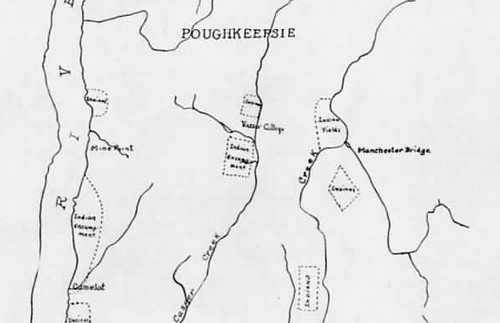The importance of Hudson River tributaries to Native Americans
July 19, 2010 by admin
 Professor Lucy Johnson at the U-puku-ipi-sing site
Professor Lucy Johnson at the U-puku-ipi-sing site
Last Friday, as part of Dutchess Watershed Awareness Month, archeologist Lucy Johnson of Vassar College led a walk-and-talk to a very special place in local history. She took us to the spring, known as U-puku-ipi-sing, which gave Poughkeepsie its name. Although it is not located within the Casperkill watershed, the history of this site sheds light on the role that local springs and streams, such as the Casperkill, may have played in the lives of Native Americans. Lucy Johnson spoke about the importance of the Hudson River and its tributaries for the Valley’s earliest inhabitants:
The Hudson River has been a major artery of traffic for the past five to eight thousand years. The Hudson had a real advantage for Native people whose only way of powering their boats was to paddle, which is that it runs both ways. The people living along its shores clearly understood that when the tides were running in, they could go upriver easily and when the tides were running out, they’d go really fast downriver. But there was a problem with that. A little south from here the water is brackish and therefore not drinkable. That means that all of these side-watersheds that feed into the Hudson were extremely important because they brought down fresh water, and therefore Native Americans could drink from them. They were also important because they provided access to the interior, so people could go up the Casperkill or the Fallkill and into the prime farmland.
Apart from facilitating access to farmland and freshwater, the tributaries also provided attractive habitat for wildlife and vegetation. The Native Americans made good use of these natural resources. They adapted streamside plants, such as cat-tails, elm bark, native hemp, and cedar bark to the construction of buildings and making of materials like mats and bags. The berries and fruits that grew along streams were also a good source of food, as were the deer, raccoons, beavers and other creatures that lived on the stream banks.
The U-puku-ipi-sing spring, however, had a very particular role in the lives of Native people in this area. It feeds a small creek that eventually flows into the Hudson River (starting at what is today the Maple Grove estate and running through the Poughkeepsie Rural Cemetery). Lucy Johnson explains why this small watershed, with a name that translates as “little reed house by the water”, was so important to the Native Americans:
You may or may not know that Route 9 is an old Indian trail. This road that goes all the way up the East side of the Hudson has been here since before the arrival of the first Europeans. It was a well-worn, well-used trail by the Native Americans. If a group was hiking that trail, they may not have wanted to camp by the river, particularly if it was a period of tension between different groups of Natives. So they could come very close to the trail, but stay down here by this nice source of fresh water. Another translation that I have heard of U-puku-ipi-sing is “meeting place.” It also may have been a place where people from the river tribes and the inland tribes met to negotiate and trade.
The U-puku-ipi-sing watershed is too small to be navigable. Therefore the Natives didn’t have to worry about people coming up from the Hudson—even an itty-bitty canoe wasn’t going to make it up that stream —as they did if they were on the Fishkill or the Wappingers or even the Fallkill or the Casperkill. So, this would have been a really nice place as a temporary camp. And all of the names that we have for it suggest that it was a temporary camping place along the river. Then, obviously, the Dutch found it and collected the name and named their settlement that they put a little upriver from it Poughkeepsie, which seems rather strange since it’s between the Fallkill and the Casperkill. You’d think they would have named it after either of those. But this was probably the place where the Dutch came to trade with the Native groups and that might have been why this little spring gave its name to the City and Town that we live in.

Many years ago, Helen Wilkinson Reynolds, former County historian, and Edith A. Roberts of Vassar College, also wrote about Native American presence in the area. In their 1938 book, The Role of Plant Life in the History of Dutchess County, the authors included a map highlighting the various Indian encampments that may have existed in the County, noting that:
…. a typical Algonquin site is a gently sloping knoll at the junction of two streams. These sites in Dutchess County therefore are typical. The areas that were occupied then are still under cultivation today and show that the white settlers of the County agreed with the Indians in the selection of areas for development.
Hence, it is not surprising that the map shows two Native American camps at the junction of the Casperkill and Fonteynkill creeks, where Vassar College is located today.
To read more about pre-20th century history of the Casperkill watershed, see Harvey Flad on the history of the Casperkill Watershed
Information and map from:
Roberts, Edith Adelaide and Reynolds, Helen Wilkinson. The role of plant life in the history of Dutchess county. New York: Lansing Broas Printing Co., Inc., 1938, pp. 11-21